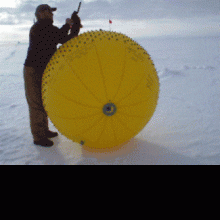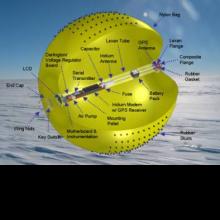The Tumbleweed Rover, a completed project from the Jet Propulsion Laboratory (JPL) in Pasadena, California, is a large, wind-blown, inflated ball, which carries an instrument payload in its interior. Such rovers offer an effective and simple means of gathering data over large spatial extents of Earth, Mars, and other solar system bodies. Tumbleweeds could prove to be a safe and economical way of deploying instruments such as a ground penetrating radar or a magnetometer in numerous hostile environments. A version of the rover was recently deployed in Greenland, where it completed a more than 100km autonomous traverse across an ice sheet. Communicating via the Iridium satellite network, the rover in question successfully and reliably relayed live GPS, temperature, and pressure data to a ground station at JPL for nearly ten days. The follow-on rover traversed from the South Pole to the coast of Antarctica some 2000km away. The Antarctic test, which took place in February of 2004, obtained mapping data in collaboration with the ADD project of the British Antarctic Survey to demonstrate Tumbleweed's effectiveness in harvesting data in extreme and remote settings.
The Tumbleweed Rover can be windblown and used to explore the surfaces of Earth, Mars, Venus, Titan, and perhaps Saturn’s moon Io (via supersonic volcanic wind) and Neptune’s moon Triton (as evidenced by significant surface wind erosion).
For each of these applications, various central payloads could be held in place by a series of lines that extend to the outside of the ball. Various versions of this basic concept have been proposed in the past in the U.S. and France, but JPL is the first to actually develop the ball and prove its feasibility experimentally and analytically. In the case of Mars, a 6-m diameter ball is easily capable of climbing over one meter rocks and up 25Љ hills (well over 99.9% of the Martian surface) with typical global winds that occur during the southern summer. The ball could also potentially be used as a parachute on Mars (30 m/sec descent rate) and as an airbag, thus serving as its own landing system. Similar large balls, but without the central payload, have also been shown to be useful as tires for an Inflatable Rover that has been successfully tested at JPL.
Field tests have been successfully conducted of scale models of the physical ball in the Mojave Desert, California, Pt. Barrow, Alaska, and a long-distance test with an instrument payload and satellite communications was recently conducted in Greenland. In the Greenland deployment, Tumbleweed covered over 130km in less than 48 hours while reliably sending back data to a ground station located at JPL every 30 minutes.
More information available at the NASA JPL Robotics website: Tumbleweed


